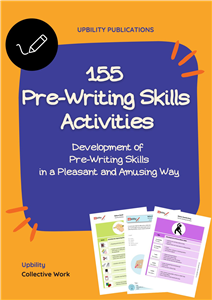155 Pre-Writing Skills Activities
The book '155 Pre-Writing Skills Activities' is ideal for initiating the child into the school world. Its objective is to teach the child how to grip and use the pencil correctly.
by Collective Work – Upbility
155 Pre-Writing Skills Activities – A Fun & Engaging Learning Experience! Age Group: 4+ 🖍️ Helping Children Build a Strong Foundation for Writing! The "155 Pre-Writing Skills Activities" book is designed to develop essential motor skills and prepare young learners for writing success through engaging and structured exercises. 📝 What’s Inside? The book is divided into two key sections: 🔹 Section 1: Interactive Motor Skill Development ✔ Fine & gross motor skill exercises to strengthen hand muscles. ✔ Tactile & visual perception activities to enhance coordination. ✔ Bilateral coordination tasks for smoother hand-arm functionality. 🔹 Section 2: Fine Motor Skill Worksheets ✔ Drawing, coloring, copying, and writing activities. ✔ Structured practice to refine motor control. ✔ Step-by-step guidance with useful tips to ensure long-term progress. 🎯 Learning Outcomes: ✔ Improved hand strength & control for writing readiness. ✔ Better visual-motor coordination for precision. ✔ Enhanced cognitive & sensory-motor integration. ✔ Engaging and fun exercises that boost confidence in early learners. 🌟 This book is the perfect tool for parents, educators, and therapists to introduce young children to the fundamentals of pre-writing in a fun and effective way!


































